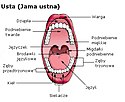Gruczoły policzkowe
Gruczoły policzkowe (glandulae buccales) – gruczoły egzokrynowe leżące w policzkach.
Gruczoły policzkowe znajdują się w obrębie policzków. Leżą one pomiędzy błoną śluzową a warstwą mięśniową policzków lub też w obrębie mięśnia budującego środkową warstwę policzka. Posiadają one ujścia prowadzące do przedsionka jamy ustnej[1].
Gruczoły te dzieli się na następujące zgrupowania (zazwyczaj występują jedynie 2 najpierw wymienione)[1]:
- gruczoły policzkowe dogrzbietowe (glandulae buccales dorsales), zwane również szczękowymi
- gruczoły policzkowe dobrzuszne (glandulae buccales ventrales), nazywane także żuchwowymi
- gruczoły policzkowe środkowe (glandulae buccales intermediae) – jest to zgrupowanie pośrednie w stosunku do dwóch uprzednio wymienionych, obserwowane u przeżuwaczy
Pewna odrębność anatomiczna występuje również u drapieżnych. Na miejsce gruczołów policzkowych szczękowych mają one gruczoł jarzmowy (glandula zygomatica)[1].
![]() Przeczytaj ostrzeżenie dotyczące informacji medycznych i pokrewnych zamieszczonych w Wikipedii.
Przeczytaj ostrzeżenie dotyczące informacji medycznych i pokrewnych zamieszczonych w Wikipedii.
Przypisy
- ↑ a b c Krysiak i Świeżyński 2012 ↓, s. 43.
Bibliografia
- Kazimierz Krysiak, Krzysztof Świeżyński: Anatomia zwierząt. T. 2: Narządy wewnętrzne i układ krążenia. Warszawa: Wydawnictwo Naukowe PWN, 2012. ISBN 978-83-01-16755-4.
Media użyte na tej stronie
Star of life, blue version. Represents the Rod of Asclepius, with a snake around it, on a 6-branch star shaped as the cross of 3 thick 3:1 rectangles.
Design:
The logo is basically unicolor, most often a slate or medium blue, but this design uses a slightly lighter shade of blue for the outer outline of the cross, and the outlines of the rod and of the snake. The background is transparent (but the star includes a small inner plain white outline). This makes this image usable and visible on any background, including blue. The light shade of color for the outlines makes the form more visible at smaller resolutions, so that the image can easily be used as an icon.
This SVG file was manually created to specify alignments, to use only integers at the core 192x192 size, to get smooth curves on connection points (without any angle), to make a perfect logo centered in a exact square, to use a more precise geometry for the star and to use slate blue color with slightly lighter outlines on the cross, the rod and snake.
Finally, the SVG file is clean and contains no unnecessary XML elements or attributes, CSS styles or transforms that are usually added silently by common SVG editors (like Sodipodi or Inkscape) and that just pollute the final document, so it just needs the core SVG elements for the rendering. This is why its file size is so small.The Star of Life, medical symbol used on some ambulances.
Star of Life was designed/created by a National Highway Traffic Safety Administration (US Gov) employee and is thus in the public domain.Autor: Kedziorek1998d, Licencja: CC BY-SA 3.0
Jama ustna - schemat opisany w języku polskim




